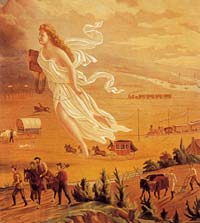The spirit of progress captured in ITEMS 5.1 and 5.3 might be said to glorify ruthless exploitation, unprincipled development and unbridled growth, though clearly the artists foresaw none of this. In America, progress was part of the country's sense of 'manifest destiny' and optimism. Such naivety was in some cases self-defeating, as in the Oklahoma and Texas 'dust bowl’, which resulted from 'tractoring out' (as it was said) the grasslands. The principal economic and human cost however, has been measured in environmental pollution, human health, and loss of wildlife and wilderness.

5.1
American progress, 1873
Lithograph after a painting by John Gast
Library of Congress, Washington, D.C.

5.2
Anon, Making a clearing near Lake Beauport, Lower Canada, c.1835-6
Watercolour, 14.6 x 23.5 cm
Public Archives of Canada
This tide of 'progress' has now been slowed only in the sense that some small pockets of land around the globe have received some protection. But the despoilation of the landscape in which we live continues apace. Each generation sacrifices a proportion of what remains to its short-run economic advantage. The challenge of containing economic development within the constraints of ecological balance has almost nowhere been taken up.

5.3
Asher B. Durand, Progress, 1853
Oil on canvas, 121.9 x 182.8 cm
The Warner Collection of Gulf States Paper Corporation, Tuscaloasa, Alabama
Smokestacks, a train on a trestle, buildings and agriculture in the far distance symbolise the irresistible march of 'progress' and its effects on the countryside. The watchful Indians from their vantage point in the natural landscape witness the fall of Nature and the rise of white man's civilisation. As historian Leo Marx has pointed out, this canvas reverses, in a curious way, those romantic nineteenth century images of the philosopher meditating upon the ruins of civilisation and the final triumph of Nature.

5.4
Anon, Moving day, c.1875
Photograph
Another vision of the future landscape comes to us from the great landscape gardeners of the eighteenth century: replacing wilderness with paradise. The family which Wheatley painted was not relaxing in a wilderness setting, but rather in a garden, a part of the 'built' environment. In these great parks, we find trees, boulders, lakes and picturesque cottages moved about as if on an artist's palette. Huge drainage channels were installed below and deer above.
Architects, gardeners, planners, and even occasional government officials have been tantalised by the notion of 'garden cities', residential and even industrial precincts reconstructed in a 'natural' setting. Such a notion mayor may not be practical, mayor may not be desirable; the question we raise here, to which there is no easy answer, is 'are they natural?'
![George and Mary Browne with their five elder children] George and Mary Browne with their five elder children]](static/files/assets/ed383f40/image94.jpg)
5.5
Francis Wheatley, George and Mary Browne with their five elder children, c. 1779
Oil on canvas, 75 x 88.9 cm
Yale Center for British Art
Paul Mellon Collection

5.6
Henry Grillen, Melbourne from the Botanical Gardens, 1867
La Trobe Collection, State Library of Victoria